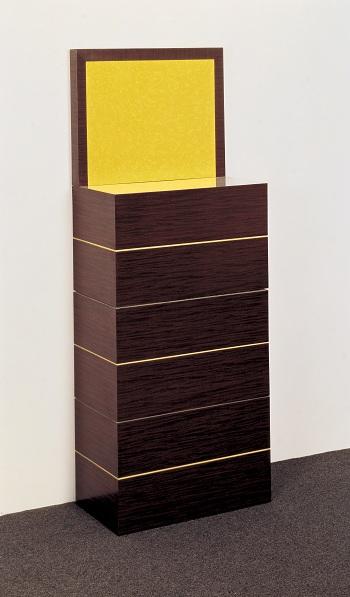Richard Artschwager, whose retrospective is currently on view at the Hammer Museum, worked in Formica, wood, and other industrial materials to explore the tension between art, everyday objects, and illusion. Artschwager's work is hard to pin down—it flirts with the boundaries between what is known as Conceptualism, Minimalism, and Pop.
What is clearly articulated in Artschwager's work is his immense attention to detail, namely for edges and angles. Portrait II, from 1963, is emblematic of Artschwager's focus not only on the object he's creating, but for the nuances that make us believe it's a recognizable, functional piece of furniture when, in fact, it is pure form.
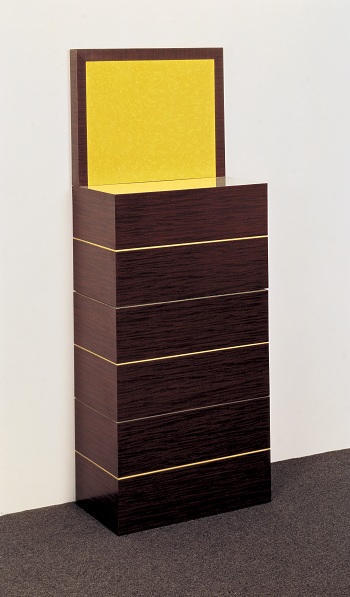 Richard Artschwager, Portrait II (detail), 1963, Yale University Art Gallery, promised gift of Anna Marie and Robert F. Shapiro, B.A. 1956. © Richard Artschwager
Richard Artschwager, Portrait II (detail), 1963, Yale University Art Gallery, promised gift of Anna Marie and Robert F. Shapiro, B.A. 1956. © Richard Artschwager
When looking at the lines that make up the points of separation between the "drawers" of this "bureau," a pattern begins to form: Artschwager staggers his articulation of the space. A gap is filled in with yellow material, a gap is left unfilled, and so on, until Portrait II meets the floor, at which it appears to be floating.
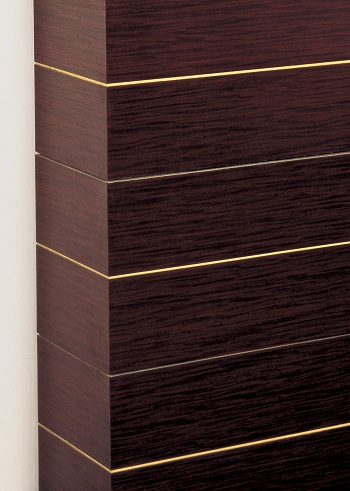 Richard Artschwager, Portrait II (detail), 1963, Yale University Art Gallery, promised Gift of Anna Marie and Robert F. Shapiro, B.A. 1956. © Richard Artschwager
Richard Artschwager, Portrait II (detail), 1963, Yale University Art Gallery, promised Gift of Anna Marie and Robert F. Shapiro, B.A. 1956. © Richard Artschwager
Donald Judd's Untitled series from 1988, while made 25 years after Artschwager's Portrait II, showcases like-minded thought of two contemporaries. In this piece (below) from the series, Judd breaks up sturdy, heavy blocks by highlighting the negative space of the wove paper.
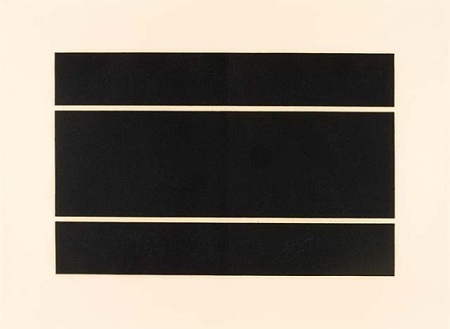 Donald Judd, Untitled, 1988, purchased with funds provided by the Graphic Arts Council, the Los Angeles County Fund by exchange, the Modern and Contemporary Art Council, Tony Ganz, and Dorothy Sherwood, © Donald Judd / Licensed by VAGA, New York, NY
Donald Judd, Untitled, 1988, purchased with funds provided by the Graphic Arts Council, the Los Angeles County Fund by exchange, the Modern and Contemporary Art Council, Tony Ganz, and Dorothy Sherwood, © Donald Judd / Licensed by VAGA, New York, NY
Judd relies on an assertiveness of edges to delineate segmented spaces. That this series is made from woodcut is especially interesting. In the relief cut of the wood block, an image is formed by cutting away at the surface of the wood. In this case, the image resulted in two lines bisecting a rectangle.
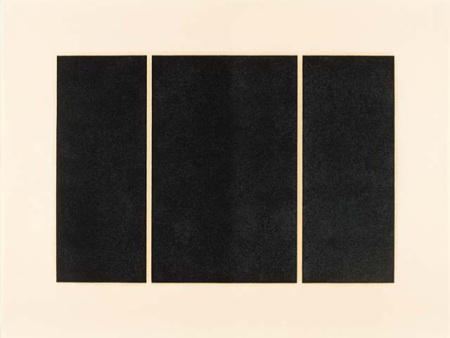 Donald Judd, Untitled, 1988, purchased with funds provided by the Graphic Arts Council, the Los Angeles County Fund by exchange, the Modern and Contemporary Art Council, Tony Ganz, and Dorothy Sherwood, © Donald Judd / Licensed by VAGA, New York, NY
Donald Judd, Untitled, 1988, purchased with funds provided by the Graphic Arts Council, the Los Angeles County Fund by exchange, the Modern and Contemporary Art Council, Tony Ganz, and Dorothy Sherwood, © Donald Judd / Licensed by VAGA, New York, NY
In 1965, Donald Judd wrote an essay, "Specific Objects," in which he observed:
"The composition must react to the edges and the rectangle must be unified, but the shape of the rectangle is not stressed; the parts are more important, and the relationships of color and form occur among them."
Like Artschwager, Judd's close study of edges is apparent in his body of work. This was one similarity in many between the two artists, whose simultaneous mountings at sister institutions in Los Angeles is fortuitous and offers an opportunity to focus on how edges made their work.
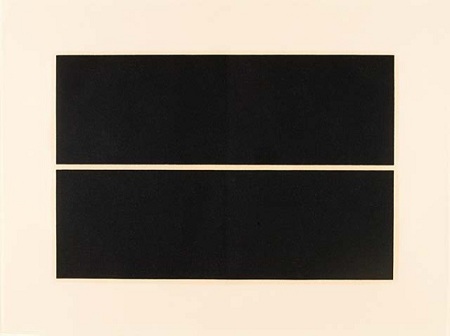 Donald Judd, Untitled, 1988, purchased with funds provided by the Graphic Arts Council, the Los Angeles County Fund by exchange, the Modern and Contemporary Art Council, Tony Ganz, and Dorothy Sherwood, © Donald Judd / Licensed by VAGA, New York, NY
Donald Judd, Untitled, 1988, purchased with funds provided by the Graphic Arts Council, the Los Angeles County Fund by exchange, the Modern and Contemporary Art Council, Tony Ganz, and Dorothy Sherwood, © Donald Judd / Licensed by VAGA, New York, NY
Donald Judd's Untitled series is on view in a special installation through Sunday, August 4, in the Ahmanson Building, Level 2. Also: don't miss Judd's spectacular Untitled (for Leo Castelli), from 1977, permanently on view in LACMA's Wilshire East Garden.
Linda Theung, editor



